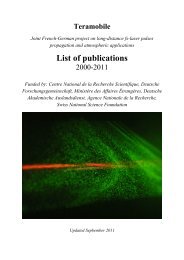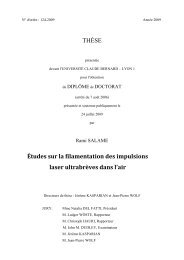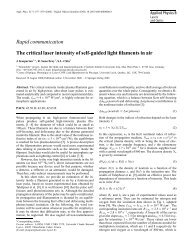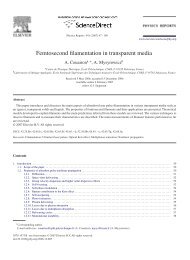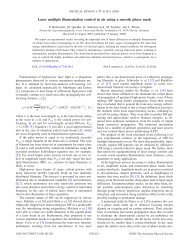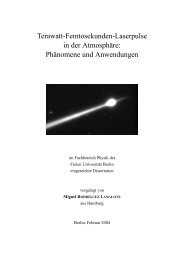Laser-induced water condensation in air - teramobile
Laser-induced water condensation in air - teramobile
Laser-induced water condensation in air - teramobile
You also want an ePaper? Increase the reach of your titles
YUMPU automatically turns print PDFs into web optimized ePapers that Google loves.
ARTICLES<br />
NATURE PHOTONICS DOI: 10.1038/NPHOTON.2010.115<br />
a<br />
b<br />
140<br />
120<br />
100<br />
Fibre bundle<br />
Backscattered<br />
light<br />
Filament<strong>in</strong>g<br />
Teramobile<br />
beam<br />
Height (m)<br />
80<br />
60<br />
40<br />
Filter +<br />
photomultiplier<br />
Digital<br />
oscilloscope<br />
Telescope<br />
Ref. PD<br />
Teramobile:<br />
800 nm, 220 mJ,<br />
120 fs, 5 Hz<br />
20<br />
0<br />
0.0 0.2 0.4 0.6<br />
PC<br />
LIDAR transmitter:<br />
532 nm, 5 mJ, 7 ns, 10 Hz<br />
1 ms<br />
Relative <strong>in</strong>crease of<br />
Mie backscatter<strong>in</strong>g (%)<br />
Figure 3 | <strong>Laser</strong>-<strong><strong>in</strong>duced</strong> <strong>condensation</strong> experiment <strong>in</strong> the atmosphere. a, Experimental set-up. The Teramobile laser (red) is fired 1 ms before the LIDAR<br />
pulse (green) measur<strong>in</strong>g the aerosol content of the atmosphere. b, Time-averaged relative <strong>in</strong>crease of the Mie backscatter<strong>in</strong>g coefficient b Mie measured<br />
between 6:00 and 6:30 with and without fir<strong>in</strong>g the Teramobile laser. The signal enhancement at the height of the filaments (the most active filament<strong>in</strong>g<br />
region at 45–75 m is shaded) is a clear <strong>in</strong>dication for filament-<strong><strong>in</strong>duced</strong> <strong>condensation</strong>.<br />
a<br />
b<br />
6<br />
290<br />
C<br />
F<br />
E<br />
D<br />
B<br />
A<br />
Saturation ratio<br />
5<br />
4<br />
3<br />
2<br />
1<br />
<strong>Laser</strong> position<br />
280<br />
270<br />
260<br />
250<br />
240<br />
230<br />
(K)<br />
0<br />
0 5 10 15<br />
Height <strong>in</strong> chamber (cm)<br />
220<br />
Figure 4 | Atmospheric diffusion chamber for laboratory experiments. a, Experimental set-up (schematic). A, Teramobile beam; B, particle sizer laser beam;<br />
C, particle sizer receiver unit; D, imag<strong>in</strong>g charge-coupled device camera; E, heat and vapour source; F, cold bottom plate. b, Measured vertical temperature<br />
(blue, right scale) and derived supersaturation profile (red, left scale) <strong>in</strong> the chamber. The dashed l<strong>in</strong>es correspond to the worst-case comb<strong>in</strong>ations of 2s<br />
temperature and chamber top saturation measurement errors. The grey region <strong>in</strong>dicates the position of the laser beam.<br />
that the observed effects depend on the weather conditions excludes<br />
a systematic experimental flaw. Furthermore, we can exclude direct<br />
contribution of the filament plasma to the LIDAR signal, because<br />
the lifetime of the plasma generated by the filaments does not<br />
exceed the microsecond timescale, well below the millisecond<br />
<strong>in</strong>terval between the pump and the probe pulses 28 .<br />
As <strong>in</strong> the cloud chamber experiment, we checked that the<br />
enhancement of the LIDAR signal by the laser filaments could<br />
not be expla<strong>in</strong>ed by laser-<strong><strong>in</strong>duced</strong> aerosol fragmentation. First, the<br />
observed effect decreases when the background LIDAR signal<br />
<strong>in</strong>creases, that is, when more <strong>water</strong> droplets are available for fragmentation.<br />
The above-described model of droplet fragmentation<br />
quantitatively confirmed this qualitative argument. Based on very<br />
high-visibility conditions and <strong>air</strong>-mass back trajectories 29 , we considered<br />
an <strong>in</strong>itial maritime haze size distribution 30 . The visibility<br />
provided the <strong>water</strong> droplet concentration, which was equal to<br />
136 mm 23 . Alternative rural, remote cont<strong>in</strong>ental and urban size<br />
454<br />
distributions were also considered, without affect<strong>in</strong>g the result<br />
qualitatively. Between 8 and 400 fragments per mother droplet<br />
were considered, with refractive <strong>in</strong>dices <strong>in</strong> the range 1.3–1.5 commonly<br />
encountered <strong>in</strong> hazes 31 . Even if an overestimation of the filament<br />
number (100) and diameter (200 mm) were taken <strong>in</strong>to account<br />
<strong>in</strong> the calculations, we found that fragmentation could <strong>in</strong>crease the<br />
Mie backscatter<strong>in</strong>g coefficient by at most 0.1–0.2%. Thus, fragmentation<br />
does not provide the dom<strong>in</strong>ant contribution to the observed<br />
effect <strong>in</strong> the atmospheric experiments.<br />
Systematic parametric measurements would be required to better<br />
understand and optimize the complex processes at play <strong>in</strong> our<br />
observations. Although such a study is beyond the scope of the<br />
present work, some important facts have to be considered. Each filament<br />
generates a cold plasma 5–8 with 10 15 –10 16 electrons cm 23<br />
(ref. 5), that is, an average charge generation rate of 10 11<br />
charges cm 23 s 21 at a repetition rate of 10 Hz. Most of these electrons<br />
attach to ions with<strong>in</strong> a few picoseconds while, typically,<br />
NATURE PHOTONICS | VOL 4 | JULY 2010 | www.nature.com/naturephotonics<br />
© 2010 Macmillan Publishers Limited. All rights reserved.




